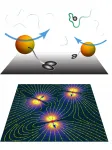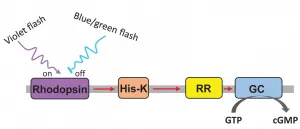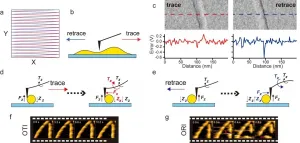First detailed look at crucial enzyme advances cancer research
2021-03-29
(Press-News.org) In order to develop more effective drugs against a range of cancers, researchers have been investigating the molecular structure of many diseased-linked enzymes in the body. An intriguing case in point is Taspase 1, a type of enzyme known as a protease. The primary duty of proteases is to break down proteins into smaller peptide snippets or single amino acids.
Taspase 1 appears to play a vital role in a range of physiological processes, including cell metabolism, proliferation, migration and termination. The normal functioning of Taspase 1 can go awry however, leading to a range of diseases, including leukemia, colon and breast cancers, as well as glioblastoma, a particularly lethal and incurable malignancy in the brain.
Because Taspase 1 dysregulation is increasingly implicated in the genesis and metastasis of various cancers, it has become an attractive candidate for drug development. But before this can happen, researchers will need a highly detailed blueprint of the structure of this protease.
In a new study appearing in the Cell Press journal Structure, researchers from Arizona State University describe their investigations, which reveal the structure of Taspase 1 as never before.
The study unveils, for the first time, the catalytically active 3D structure of Taspase 1, revealing a previously unexplored region that is essential for the functioning of the molecule. The structure was solved using X-ray crystallography and confirmed with electron microscopy.
Petra Fromme, director of the Biodesign Center for Applied Structural Discovery, highlights the great importance of the work: "I am so excited that we were able to solve the first structure of the functional active enzyme, as it will have huge implications for the structure-based development on novel anti-cancer drugs."
The study results show that reducing this critical helical region of Taspase 1 limits protease activity, while eliminating the helical region deactivates Taspase 1 functioning altogether. Earlier research suggests that disabling Taspase 1 activity to block the progression of cancer could be achieved without harmful side-effects.
"We have reported the importance of a previously unobserved long fragment of the protein in the catalytic activity of Taspase1, which can be used as attractive target to inhibit Taspase1," according Jose Martin-Garcia, lead scientist on the project and co-correponding author with professor Fromme. "The crystal structure of the active Taspase1 reported in our article will be greatly beneficial to advance the design of Taspase1 inhibitors for anti-cancer therapy."
INFORMATION:
Martin-Garcia is currently a researcher with the Department of Crystallography and Structural Biology at the Spanish National Research Council, Madrid.
Fromme and Martin-Garcia are joined by their Biodesign collaborators Nirupa Nagaratnam, Rebecca Jernigan, Brent L. Nannenga and Darren Thifault, along with their multi-institute colleagues.
[Attachments] See images for this press release:

ELSE PRESS RELEASES FROM THIS DATE:
2021-03-29
Use of vouchers and coupons offered by pharmaceutical companies to defray patients' out-of-pocket drug costs is concentrated among a small number of drugs. While these offsets significantly reduce patient costs, they are not targeted to patients who most need the price reduction, according to a study from researchers at the Johns Hopkins Bloomberg School of Public Health.
The researchers, in what is thought to be the largest study of its kind to date, analyzed tens of millions of pharmacy transactions by more than 600,000 people in the U.S. during 2017-19, in order to get a better sense of how vouchers and other point-of-sale copayment "offsets" are used. These coupons and vouchers come in many forms--some are offered online directly to customers, others by pharmacy ...
2021-03-29
When you bump into someone in the workplace or at your local coffee shop, you might call that an "encounter." That's the scientific term for it, too. As part of urgent efforts to fight COVID-19, a science is rapidly developing for measuring the number of encounters and the different levels of interaction in a group.
At the National Institute of Standards and Technology (NIST), researchers are applying that science to a concept they have created called "encounter metrics." They have developed an encrypted method that can be applied to a device such as your phone to help with the ultimate goal of slowing down or preventing future pandemics. The method is also applicable to the COVID-19 pandemic.
Their research ...
2021-03-29
A drop of food coloring slowly spreading in a glass of water is driven by a process known as diffusion. While the mathematics of diffusion have been known for many years, how this process works in living organisms is not as well understood.
Now, a study published in Nature Communications provides new insights on the process of diffusion in complex systems. The result of a collaboration between physicists at Penn, the University of Chile, and Heinrich Heine University Düsseldorf, this new theoretical framework has broad implications for active surfaces, such as ones found in biofilms, active coatings, and even mechanisms for pathogen clearance.
Diffusion is described ...
2021-03-29
BUFFALO, N.Y. - Bullying at boarding schools has a negative impact on students' emotional health, but for male students, having a school staff member to rely on for support may mute the harmful effects of bullying, according to a new University at Buffalo study. Support networks did not have the same effect for female students, the researchers say.
The study, recently published in School Psychology Review, is one of few to examine the impact of bullying at boarding schools, which provide a unique environment where most students live on school grounds, away from their families. It is also one of the first studies to observe the effects ...
2021-03-29
Climate labels informing us of a meat product's carbon footprint cause many people to opt for climate-friendlier alternatives. This applies to people who are curious about a product's carbon footprint, as well as to those who actively avoid wanting to know more. The finding is published in a new study from, among others, the University of Copenhagen. As such, climate labeling food products can be a good way of reducing our climate footprint. But according to the researcher behind the study, labels must be obligatory for them to be effective.
Certain situations exist where we humans strategically avoid greater knowledge and more information - a phenomenon known as "active information avoidance". ...
2021-03-29
The unicellular green alga Chlamydomonas reinhardtii has already given research a massive boost: One of its light sensors, channelrhodopsin-2, founded the success of optogenetics about 20 years ago.
In this technology, the alga's light sensor is incorporated into cells or small living organisms such as threadworms. Afterwards, certain physiological processes can be triggered or stopped by light. This has already led to several new scientific findings, for example on the function of nerve cells.
Now the green alga Chlamydomonas is once again setting an accent. Once again, it is its light sensors, ...
2021-03-29
High-speed atomic force microscopy (HS-AFM) is an imaging technique that can be used for visualizing biological processes, for example the activity of proteins. Nowadays, typical HS-AFM frame rates are as high as 12 frames per second. In order to improve the capabilities of the method, so that it can be applied to an ever expanding range of biological samples, better video rates are needed, though. Moreover, faster recording times imply less interaction between the sample and the probe -- a tip scanning the sample's surface -- making the imaging ...
2021-03-29
A team of researchers, led by the Instituto de Ciencias del Patrimonio (Incipit-CSIC) and the Instituto de Astrofísica de Canarias (IAC), in collaboration with the team from the Arqueological Zone of Caral (Perú) led by Dr. Ruth Shady Solís, has established the relation between the position of the monuments of the Supe Culture (Perú), their orientations, and some astronomical and topographic features, which opens the way to the analysis of the way the inhabitants of this valley conceived space and time 5000 years ago. The results of the study have just been published in the journal Latin American Antiquity.
The valley of the river Supe in Perú contains the first evidence for city building in the Americas. In recent decades in this valley and ...
2021-03-29
Next-gen electronics is envisioned to be non-rigid, component-free, flexible, bendable, and easily integrable with different objects.
Direct-write printing techniques provide unique opportunity to enable this vision through use of nanomaterial so-called functional inks, that can be tailored to add desired functionalities on various flexible substrates, such as textiles or plastic.
The technology, known as Printed Electronics (PE), has been known for decades, but has recently gained considerable attention due to innovation in material inks, process technology and design revolution.
To keep the research community abreast with the latest technological advancements in the area of droplet-based PE techniques for next-gen devices, researchers from Aarhus University have now ...
2021-03-29
Kanazawa, Japan - Solar cells are excellent renewable energy tools that use sunlight to drive an electrical current for power. They've been used to power homes since the 1980s, and their performance and production cost have improved dramatically since then. The most common solar cells, based on silicon, work well for a long time. They retain more than 80% of their functionality even after 25 years. However, the efficiency--i.e., how much of the incoming sunlight is converted to electrical power--of commercial-scale silicon solar cells is currently only around 20%.
Maximizing solar cells' energy conversion efficiency will improve their competitiveness compared to fossil fuels and help optimize them as a sustainable ...
LAST 30 PRESS RELEASES:
[Press-News.org] First detailed look at crucial enzyme advances cancer research






